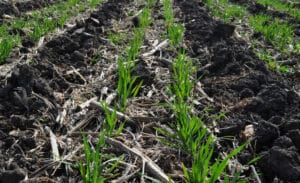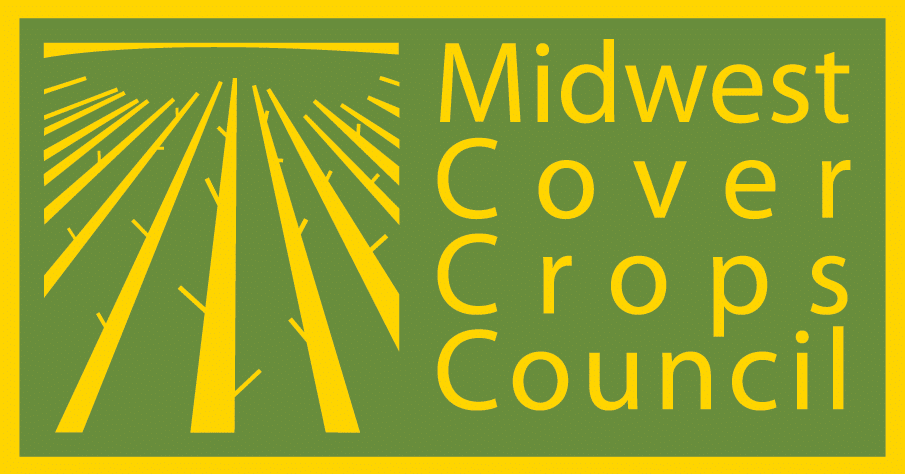Midwest Cover Crops Council (MCCC-115)
This publication is intended to provide a starting point for farmers who are new to growing cover crops. With experience, farmers may fine-tune the use of cover crops for their systems.
Introduction
Using cover crops can be challenging in a corn-soybean rotation in Minnesota due to a short growing season. Typically, there is little to no time to plant a cover crop and have appreciable growth after corn grain or soybean harvest. Planting a cover crop after small grains, a canning crop, or corn silage will often provide a wider window for establishment before a killing freeze. In a corn-soybean rotation, it is easier to begin by planting a cover crop ahead of soybean and following corn, so consider starting with the companion recipe titled Post Corn, Going to Soybean: Use Cereal Rye (MCCC-114; see Resources).
However, cover crops that are planted post soybean and going to corn provide soil protection and organic matter inputs, so the following recipe provides a low-risk, introductory approach for this window. Oats were selected following soybean in a corn-soybean rotation because oats (1) are typically readily available and inexpensive, (2) tend to be more tolerant to many herbicides, and (3) winter-kill, which eliminates the need for a termination plan in the spring and reduces the risk of a green bridge for disease or insect pests to corn.
Planning and Preparation
- Planning—Educate yourself. Go to field days, learn from farmers who are currently planting cover crops, read about cover crops, check out University of Minnesota cover crop research, and work with your local Natural Resources Conservation Service (NRCS) and Soil and Water Conservation District. Start small, and choose a field that has low weed pressure to help create the best conditions for success. Consult with your crop insurance representative to ensure planned practices will not impact your insurance coverage.
- Soybean planting—If possible, plant the preceding soybean crop early and avoid varieties that are very full season for your area. One possible strategy is to use your earliest-maturity group soybeans on fields where you plan to seed a cover crop. For more information, see Soybean Variety Selection.
- Residual herbicides—Manage for optimal weed control when adding a cover crop to your cropping system. Apply a preemergence herbicide to help control troublesome weeds such as waterhemp, which emerges over a long period of time and late in the season. Preemergence herbicides also aid in the management of weeds that are resistant to key postemergence herbicides. Oats are tolerant to many soybean residual herbicides, but if the oats are to be grazed or used for feed or forage, you must follow the rotational crop restrictions listed on the label of any applied herbicides. (In the Resources section, see Managing Risk When Using Herbicides and Cover Crops in Corn and Soybean.)
- Seed purchase—Order cover crop seed early from a reputable source. Use good-quality tagged seed that has been cleaned and tested for germination and weed seed contamination. Avoid planting seed of unknown origin and quality. Named varieties can produce greater growth and have more predictable development, but they are usually more expensive than VNS (variety not stated) seed.
Fall Work
- Timing of cover crop planting—Given the limited time for cover crop establishment after harvest, interseeding a cover crop into standing soybean when leaves start to yellow and drop (around beginning maturity) is preferred. This should correspond to a seeding timing of late August to early September in most of Minnesota. Pay attention to the short-term weather forecast as rainfall after seeding is essential for establishment. Seeding the cover crop immediately after soybean harvest is also possible, particularly where soybeans were drilled, planted in narrow rows, or had extensively lodged. However, this timing may not provide enough time for adequate cover crop growth and development before a killing frost in the fall.
- Planting method—Aerial seed with a plane or helicopter or broadcast seed with a ground-based vehicle into the standing soybean crop. Alternatively, if seeding after soybean harvest, drill to a depth of 0.50 to 1 inch or broadcast with shallow (<1 inch) incorporation.
- Seeding rate—A seeding rate of 45 to 65 lbs./acre of pure live seed (PLS) is suggested when seed is broadcasted and not incorporated. A seeding rate of 30 to 45 lbs./acre of PLS is recommended when seed is drilled.
- Soybean harvest—Harvest fields where the cover crop is to be planted as early as possible. This is not as critical when cover crops are seeded before harvest.
- Tillage, fertility, or liming—It is generally easier to incorporate cover crops into a no-tillage or strip-tillage system. If full-width tillage is planned, it is best to delay this until after a killing frost to allow for maximum growth of the oat cover crop. If N fertilizer or manure will be injected in the fall, it is usually best to wait until after the cover crop has winter-killed. Use a low-disturbance applicator to minimize incorporation of surface residues.

Spring Work
- Termination—Oats should winter-kill, so termination is not needed.
- Corn planting—Most modern row planters are fully capable of planting corn into residue from soybean and an oat cover crop. Row cleaner attachments may be beneficial. Check planting depth and seed furrow closure shortly after beginning to plant in case any planter adjustments are needed.
- Scouting after planting—As usual, scout for corn emergence, population, and insect pests after planting. Also, scout for weeds, particularly if there is substantial oat and/or soybean residue as this could delay weed emergence and ultimately affect the timing of postemergence herbicide applications.
Resources
University of Minnesota Extension Cover Crops Website
Cover Crop Seeding Guide (Minnesota Agronomy Technical Note 33)—available from the USDA–Natural Resources Conservation Service)
Post Corn, Going to Soybean: Use Cereal Rye (Minnesota Cover Crop Recipe series, MCCC-114)—available from the Midwest Cover Crops Council
Managing Risk When Using Herbicides and Cover Crops in Corn and Soybean (University of Minnesota Extension)
USDA–Risk Management Agency Cover Crops
Authors
Lizabeth Stahl, University of Minnesota Extension; Anna Cates, University of Minnesota Extension; Axel Garcia y Garcia, University of Minnesota Extension; and M. Scott Wells, University of Minnesota Extension (Note: This publication was adapted with consent from MCCC under a joint project to produce customized introductory guidance about cover crops for all member states/provinces.)
Reviewers and Contributors
Marisol Berti, North Dakota State University; Frank Forcella, USDA-ARS; Eileen Kladivko, Purdue University; Anna Morrow, Midwest Cover Crops Council; and Bruce Potter, University of Minnesota Extension
The Midwest Cover Crops Council (www.https://www.midwestcovercrops.org) aims to facilitate widespread adoption of cover crops throughout the Midwest by providing educational/outreach resources and programs, conducting new research, and communicating about cover crops to the public.
Funding for this project was provided by McKnight Foundation.
October 2019
The U.S. Department of Agriculture (USDA) prohibits discrimination in all its programs and activities on the basis of race, color, national origin, age, disability, and where applicable, sex, marital status, familial status, parental status, religion, sexual orientation, genetic information, political beliefs, reprisal, or because all or a part of an individual’s income is derived from any public assistance program. (Not all prohibited bases apply to all programs.) Persons with disabilities who require alternative means for communication of program information (Braille, large print, audiotape, etc.) should contact USDA’s TARGET Center at (202) 720-2600 (voice and TDD). To file a complaint of discrimination write to USDA, Director, Office of Civil Rights, 1400 Independence Avenue, S.W., Washington, D.C. 20250-9410 or call (800) 795-3272 (voice) or (202) 720-6382 (TDD). USDA is an equal opportunity provider and employer. ©2019 by MCCC. All rights reserved.
